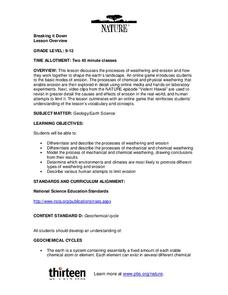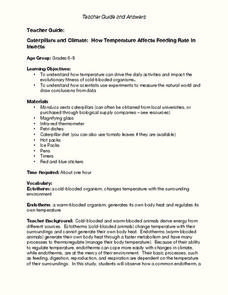Curated OER
Animal and Plant Habitats
Second graders write and illustrate a story. In this habitats lesson, 2nd graders learn about different types of plant and animal habitats. Students view video segments about habitats, answer comprehension questions, complete a crossword...
Curated OER
Modeling an Oil Reserve
Young scholars conduct an experiment. In this oil and natural gas lesson, students learn how geoscientists identify and explore reserves of petroleum. Young scholars make a model of an oil reserve, record how much it would...
Curated OER
My Life As An Insect In Namib
Middle schoolers examine the harsh living environment of the Namib Desert. They watch and discuss a video, record the types of insects observed in the video, record information about insects and animal adaptations in their science...
Curated OER
Using Heat
The different types of heating systems are listed here with a few details about each type. The four slides inform your students about the efficiency and efficacy of the heat engines and renewable sources of energy.
Curated OER
Learning the Basic Levers...One, Two, Three: Different Basic Arrangements Levers
Fifth graders read information about levers. They complete worksheets to summarize their learning. This lesson relies heavily on the Silver Burdett Ginn text, Science Discovery Works, Energy, Work, and Machines. The lesson will not be...
Curated OER
A Collection of Lights
The purpose of the slide show is to help learners understand that there are different types of lights, that they have an on/off switch, and that they can be made out of a variety of materials. There are quite a few nice pictures of lamps...
PBS
Breaking it Down
After challenging themselves to correctly choose the form of erosion and length of time required for a given landform to develop, earth science class members model mechanical and chemical weathering with various lab demonstrations over...
Merck KGaA (Darmstadt, Germany)
EMD PTE
You can't tell by the title, but this is a functional periodic table of elements. Incorporating bright colors, lucid text, and easily operated features, this application serves as a valuable reference tool for your chemistry class.
Curated OER
Caterpillars and Climate: How Temperature Affects Feeding Rate In Insects
Do you eat more when you are hot or when you are cold? Young scientists observe the eating pace of two caterpillars at different temperatures. The differences in endotherm and ecotherm animals' ability to adjust to temperature change...
Curated OER
Computer Graphing
Students research the Internet or create surveys to find graphable data. They collect, organize, analyze and interpret the data. Finally, they choose the appropriate type of graph to display the data and find the measures of central...
Curated OER
Making Waves with the Electromagnetic Spectrum
Students examine different types of electromagnetic waves and their sources. In this electromagnetic waves lesson students view a video and complete a handout.
Curated OER
Lights On!
Students work together to build their own simple circuits. They discover how electricity is conducted through light bulbs. They compare and contrast the differences beween a parallel and series circuit.
Curated OER
Let There Be Light
Pupils observe that different lights have different effects on matter. Students see that ultraviolet light is powerful although it cannot be seen through this teacher led demo-experiment.
Curated OER
TE Activity: Racing with the Sun - Creating a Solar Car
Learners use a purchased kit to build a solar powered car. They connect a solar photovoltaic panel to a motor which runs the car forward and backward. They determine how to wire the car to move in both directions.
Curated OER
Heat Absorption
Learners examine how heat moves from substance to another. For this heat absorption lesson students identify ways that heat is transferred and analyze data.
Aquarium of the Pacific
Ecosystem Comparison
Fifth graders examine plants and animals in two ecosystems and compare them. In this ecosystem survival instructional activity, 5th graders compare and contrast a coral reef and kelp forest ecosystem. Students investigate the...
Curated OER
What Does Motion Have to do with Sound?
Second graders investigate and explore sound energy. They investigate how the vibrational motion moves through matter in waves. Students describe sounds and vibrations. They observe that vibrational motion creates sounds. Students record...
Curated OER
Hunger/ Nutrition
Seventh graders investigate nutrients and nutrition to determine what types of food the body needs for energy. They study each type of nutrient and why it is important to the body. They determine what a balanced diet is by completing the...
Curated OER
Conductivity
Young scholars work together to create a simple conductivity tester. They discover the difference between conductors and insulators. They test different types of materials for their conductivity as well.
Curated OER
Rice Nutrition
Third graders investigate nutrition by researching rice. In this food lesson, 3rd graders read about the healthy aspects of rice and how many people in the world eat it. Students read nutrition labels and discuss the...
Curated OER
Heat Misconceptions
Third graders determine that gloves do not provide heat, but rather, they insulate or hold in any heat that is in their hand. They discuss the different temperatures found in ecosystems around the world. What do animals that live in...
Curated OER
You Light Up My House
Students explore renewable and nonrenewable resources. In this electricity lesson plan, students consider way to reduce the energy that they use as they chart and analyze their own electricity usage.
Curated OER
Classification of Clouds
High schoolers view a cloud slide show presentation and identify types of clouds. They estimate height based on cloud's appearance. They discuss the vague nature of cloud nomenclature and compare it to the English standard measurement...
Curated OER
LESSON PLAN: CONTROLLING NUCLEAR WEAPONS: DEBATING THE NON-PROLIFERATION TREATY
Ninth graders examine various nuclear weapons. In this American Government lesson, 9th graders conduct primary source research to investigate nuclear weapons and the international nuclear Nonproliferation Treaty. Students compose a...

























